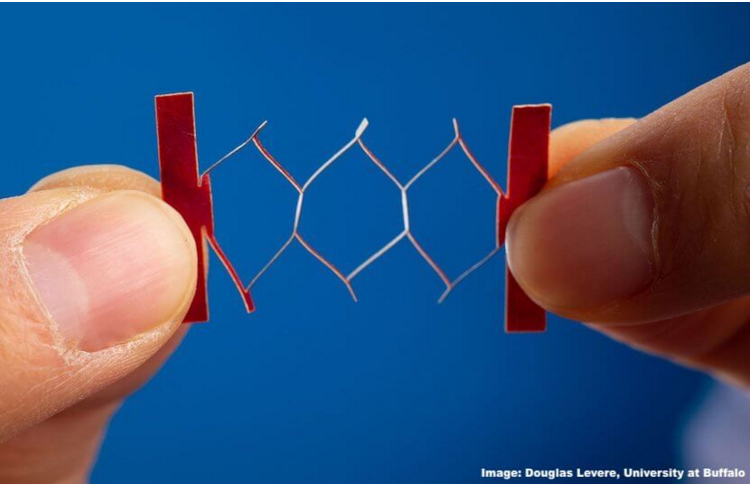Ancient Paper Art To Spur Development of Smart Clothing

Inspired by the ancient Japanese paper art of kirigami, a team of researchers from the University at Buffalo (UB) has developed amethod to create flexible electronic materialsmade of polymers and nanowires.
This new technique could lead to improvements in smart clothing, bendable display screens, electronic paper, and other applications that require malleable circuitry.
The full paper, which describes the method, is published in the journalAdvanced Materials.
Traditionally, electronic materials are hard, rigid and non-flexible. This has made it difficult for scientists to develop bendable electronics that don’t break.
But this new technique accommodates large stretchability, which would generally destroy electronic properties of materials, saidShenqiang Ren, UB professor in the Department of Mechanical and Aerospace Engineering and lead author of this research.
“New stretchable materials and devices inspired by kirigami-design address this issue by combining high performance electronic properties with large stretchability together in one single material, which enables significant deformability, twistability and bendability,” said Ren.
Through its ability to expand and bend without breaking, stretchable electronic materials can adapt and move with the bends and curves in the human body. This enables the development of new mechanically-designed wearable electronic devices, such as artificial skin, smart clothing, and more.
“We examined the design principles behind kirigami, which is an efficient and beautiful art form, and applied them to our work to develop a much stronger and stretchable conductor of power,” Ren said in a statement.
Traditionally, the polymer, named PthTFB, can be bent six percent from its original shape before it changes its electronic conductivity. Through the new technique, inspired by Japanese design principles, the polymer can stretch up to 2,000 percent. Additionally, through this method, the conductivity of PthTFB increased by three orders of magnitude.
The study includes computational modeling contributions from Temple University researchers and uses nanoconfinement engineering and strain engineering, a technique used to improve device performance in semiconductor manufacturing.
Out of the many potential applications for this technique, the researchers claim that smart clothing will be the most useful. This industry is predicted to reach a value of $4 billion by 2024.
As for the next step in development, Ren and his team are “integrating this material with functional devices with the abilities of sensing and energy conversion for self-powered electronics,” he explained.
Ren is excited about the future applications of this technique, but acknowledges that “it will take time to engineer all aspects for large-scale applications.”
Ren is also a member of UB’sRENEW Institute, which develops research, education and outreach programs regarding energy and environmental issues and their social and economic ramifications.
This research was supported by the U.S. Department of Energy.
byJackson Schroeder fromhttps://www.tun.com
Are you ready to upgrade for your clothing brand?
Welcome to contact us by sending an e-mail tosales@eleheat.com.cn
Eleheat will provide you professional One-Stop Solution for Smart Clothing.
Make you Clothing more Functional and Comfortable.
